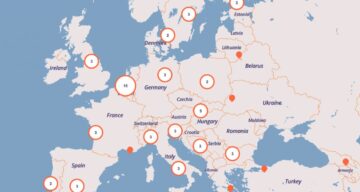HUB-IN Röportajları: Tarihi Kentsel Alan (HUA) projelerine yönelik Finansman Modellerine odaklanma
Miras yenileme finansman ortamı geliştikçe yeni fırsatlar ortaya çıkıyor. Geçmiş ve mevcut projelere bakıldığında finansman ağırlıklı olarak klasik kamu ve özel finansman kaynaklarından gelmektedir. Ancak kitlesel fonlamanın ve topluluk fonlamasının giderek daha fazla fon karışımının bir parçası haline geldiğini keşfedeceğiz.
HUB-IN Places, geleneksel kamu finansman akışlarını diğer (özel) finansman kaynaklarıyla birleştirerek yeni finansal yapıları denemeye cesaret ediyor. İçinde yeni finansal yapılar oluşturmakHUB-IN şehirleri, güç ve etki dağılımındaki potansiyel değişimleri dikkatli bir şekilde dengeleyerek şehirlerinin kapsayıcı ve sürdürülebilir kalkınmasına katkıda bulunur.
Bugünün Uzmanı: Tine De Moor from Rotterdam School of Management – Erasmus University

Tine De Moor – Professor Social Enterprise &
Institutions for Collective Action, Erasmus University
Rotterdam.
Rotterdam school of management– Rotterdam School of Management primary focus is on developing business leaders with international careers who can become a force for positive change by carrying their innovative mindset into a sustainable future.
What are institutions for collective action?
Institutions for collective action are organisations formed bottom-up by the immediate stakeholders, whose aim is to work together to pursue personal (material) and societal interests. Historically institutions for collective action keep emerging. Whenever there is a common need, people can organise to collectively arrange that need. Normally, sufficiency is a principle, participants don’t need or take more than what’s necessary. Often there are regulations around the sufficiency principle. Profits are distributed based on needs, not wants. These are the principles of the commons.
What’s the status quo today?
At this stage the most important thing is to recognize the diversity among initiatives and their contexts. There is not one single approach. Cooperatives for example offer different ways to keep the social and economic returns in the loop. In energy generation social returns are usually a by-product that comes at a later stage. While in health cooperatives, the social return is more relevant from the start.
How can institutions for collective action enable healthy business models in urban heritage regeneration?
It can be a big help if the community can really utilise the heritage site. There’s an example of a school building that was used for classes during the day, and for workshops of local entrepreneurs in the evening. The sharing economy really is a good opportunity for making different business models possible. This does require a good inventorisation of the needs of the different users. Can people find each other in the different functions? Financing is not just collective capital, but also avoiding costs.
Zorluklar nelerdir?
Underestimating the actual costs of maintaining heritage is a risk. Citizen collectives need to make realistic plans. Civil servants should take each citizen-collective seriously. But also expect those collectives to take the heritage regeneration seriously. Trust is a key issue. Do the public institutions and funders believe in the community? And vice versa? Civil servants are also citizens in the end. Also, the most active citizens tend to be the more privileged, governments should take care that heritage regeneration happens inclusively.
Focus : Institutions for collective actions
Collective action ‘consists of all occasions on which sets of people commit pooled resources, including their own efforts, to common efforts’ (Tilly and Tilly, 1981). It is, however, not unusual for members of those organisations to also have been involved in protest movements, as for example in many urban and rural revolts in the late medieval Low Countries (see e.g. the Flemish Battle of Spurs (1302)), but many more examples can be found.
Apart from setting rules to regulate the use of resources, access to the institution is usually strictly regulated. Whereas collective action in the broad sense can involve large masses of anonymous individuals, institutions for collective action are characterized by exclusiveness: only those that meet certain conditions can become a member.
Examples of institutions for collective actions are Commons, Guilds, Waterboards, Beguinages, Cooperatives.
Kaynak: www.collective-action.info
- SEO Destekli İçerik ve Halkla İlişkiler Dağıtımı. Bugün Gücünüzü Artırın.
- Plato blok zinciri. Web3 Metaverse Zekası. Bilgi Güçlendirildi. Buradan Erişin.
- Kaynak: https://www.crowdfundinghub.eu/hub-in-interviews-talking-institutions-for-collective-action/?utm_source=rss&utm_medium=rss&utm_campaign=hub-in-interviews-talking-institutions-for-collective-action
- a
- erişim
- Action
- eylemler
- aktif
- Türkiye
- arasında
- ve
- Anonim
- ALAN
- etrafında
- kaçınma
- Bakiye
- merkezli
- Savaş
- müşterimiz
- olma
- Inanmak
- Büyük
- geniş
- bina
- iş
- Başkent
- hangi
- kariyer
- dikkatlice
- taşıma
- belli
- zorluklar
- değişiklik
- özelliği
- Şehirler
- vatandaş
- Vatandaşlar
- sınıflar
- klasik
- Toplu
- toplu olarak
- birleştirme
- işlemek
- ortak
- Avam
- topluluk
- koşullar
- bağlamlar
- katkıda
- maliyetler
- ülkeler
- Crowdfunding
- akım
- gün
- gelişen
- gelişme
- farklı
- keşfetmek
- dağıtıldı
- dağıtım
- Çeşitlilik
- Dont
- sırasında
- her
- Ekonomik
- ekonomisini
- çabaları
- ortaya çıkan
- etkinleştirmek
- enerji
- kuruluş
- girişimciler
- akşam
- örnek
- örnekler
- beklemek
- deneme
- uzman
- mali
- Finansman
- bulmak
- odak
- Zorla
- Airdrop Formu
- oluşturulan
- bulundu
- itibaren
- fonksiyonlar
- finansman
- gelecek
- nesil
- Tercih Etmenizin
- Hükümetler
- olur
- Sağlık
- sağlıklı
- yardım et
- miras
- tarihi
- tarihsel
- Ancak
- HTTPS
- Acil
- önemli
- in
- Dahil olmak üzere
- dahil
- giderek
- bireyler
- etkilemek
- girişimler
- yenilikçi
- Kurumsal
- kurumları
- Uluslararası
- görüşme
- Röportajlar
- dahil
- ilgili
- konu
- IT
- tutmak
- anahtar
- manzara
- büyük
- Geç
- liderleri
- yerel
- bakıyor
- Düşük
- yapmak
- Yapımı
- yönetim
- çok
- Kitleler
- malzeme
- maksimum genişlik
- ortaçağ
- Neden
- Üyeler
- Mindset
- modelleri
- Daha
- çoğu
- hareketler
- gerekli
- gerek
- ihtiyaçlar
- yeni
- normalde
- roman
- günler
- teklif
- ONE
- Fırsatlar
- Fırsat
- örgütsel
- Diğer
- kendi
- Bölüm
- Katılımcılar
- geçmiş
- İnsanlar
- kişisel
- Yerler
- ağladım
- Platon
- Plato Veri Zekası
- PlatoVeri
- pozitif
- potansiyel
- güç kelimesini seçerim
- ağırlıklı olarak
- birincil
- prensip
- ilkeler
- özel
- ayrıcalıklı
- profesör
- kar
- Projeler
- protesto
- halka açık
- реалистичный,en
- tanımak
- düzenlemek
- düzenlenmekte olan
- yönetmelik
- uygun
- gerektirir
- Kaynaklar
- dönüş
- İade
- kurallar
- Kırsal
- Okul
- duyu
- Setleri
- ayar
- paylaşımı
- Vardiyalar
- meli
- tek
- yer
- Sosyal Medya
- Toplumsal
- kaynaklar
- Aşama
- paydaşlar
- başlama
- Durum
- dere
- sürdürülebilir
- Bizi daha iyi tanımak için
- konuşma
- The
- ve bazı Asya
- şey
- için
- bugün
- birlikte
- geleneksel
- Güven
- kentsel
- kullanım
- kullanıcılar
- genellikle
- yolları
- hangi
- süre
- DSÖ
- irade
- İş
- birlikte çalışmak
- Atölyeler
- zefirnet








